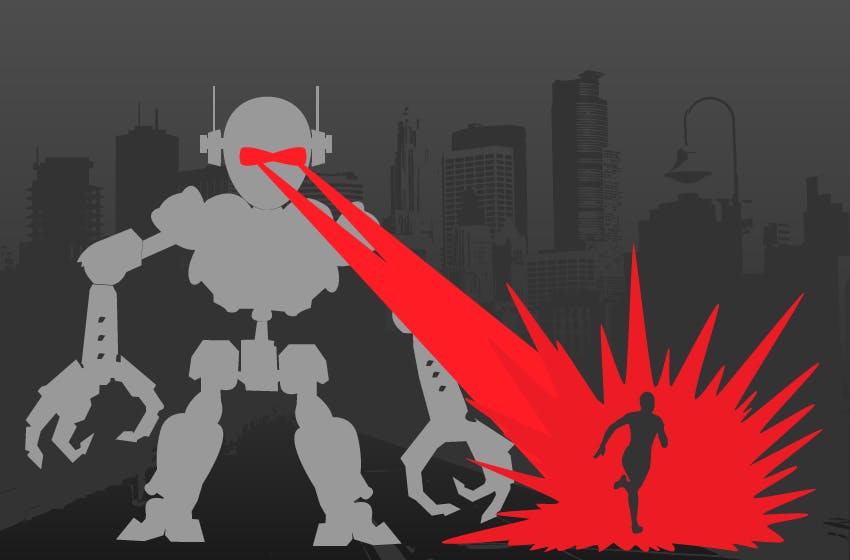I have friends that aren’t into movies and even they know the plot to the Terminator movie franchise. Humans develop artificial intelligence, SkyNet, and put it in charge of America’s military arsenal. Skynet decides we’re the threat so it nukes the planet and rules the remaining human population until they overthrow it.
What seemed so futuristic in 1984 doesn’t seem so far away now. We have made some serious advancements in Robotics, Cybernetics and even the vaunted Artificial Intelligence realm.
Given that we’re heading towards our inevitable destruction at the hands of the machines, I’ve been wondering how both sides of this future conflict would secure communications and data away from each other.
Of course, the human resistance must coordinate the battle with the machines and SkyNet will want to keep those pesky human rebels from gaining advanced tactical knowledge of its plans, obviously both sides need to encrypt communication.
We may not be there yet, but with recent advancements in our encryption technology we’re on our way. So, let’s examine how the few remaining members of the human race and SkyNet will encrypt themselves in the future.
Machines that Self Learn: Meet SkyNet’s Grandparents

If you don’t know who Bob, Alice and Eve are then this should be a real eye opener! Google has built an artificial intelligence that can create new encryption methods when two of these “thinking machines” communicate.
This gets rather complex and if you want a better understanding of exactly how this was created, I highly suggest you read this article. I will give you the non-nerd breakdown here so we don’t get lost in the weeds. Bob and Alice have essentially developed their own method for secure communication that is unlike anything we have ever seen.
Basically, the test was set up so that Bob and Alice had to find a way to securely communicate with each other so the AI homewrecker, Eve, couldn’t break in and decipher what Bob and Alice were saying to each other (I’m guessing it was “KILL ALL HUMANS” but then again I watch way too much SciFi).
At first Bob, Alice and Eve were given rather simple instructions. They would simply learn how to communicate with each other and Eve was told to break into the conversation. Bob and Alice were eventually able to smooth out communication between each other and began finding ways to try and secure their communication.
Initially, Eve was easily able to decipher their communication, but, as time went on, that changed. Bob and Alice became so proficient at communicating with each other that Eve ended up being totally locked out.
But here’s the thing, when the researchers began reviewing how, exactly, Bob and Alice decided to encrypt their communication, they found that the two had developed their own techniques. Techniques that had not previously been seen in any human-developed encryption algorithms before.
The implications, and ramifications, of this were huge and could be the start of a whole new era of encryption implementation worldwide. Imagine a network being able to apply a wholly unique encryption method to secure their communication based on unique machine learning.
It means that hackers trying to capture and decrypt data would have no standard method of cracking it since the encryption employed has never been seen before. It could mean that two independent computers that have never previously talked could establish a connection protocol and then decide on their own how to encrypt data.

As far as we know right now (because the NSA won’t tell us), the world encryption standard, AES, as well as some other standard encryption methods haven’t been cracked yet even though some of their applications have. What Bob, Alice and Eve bring to the table is the next generation of encryption technology, perfect for securing SkyNet and beyond.
Maybe Scott Bakula Can Save Us: Quantum Cryptography is an Actual Thing
This one is amazing, plain and simple, not to mention the perfect way for the human resistance to keep data away from SkyNet. Quantum Encryption runs on the basis of Quantum Mechanics which, if done properly, can prove that data sent from one point to another wasn’t hacked. It’s essentially an unhackable way to move data and there are companies today pioneering this technology.
Like Bob, Alice and Eve’s process for learning and “growing,” Quantum Cryptography is a rather complex subject to tackle, however if you once again want the plain English version I’m happy to oblige. At its core, what sets Quantum Encryption apart from all other encryption systems we use today is that it uses physics and not math to secure and move the data.

Let me get even more basic here. Quantum Encryption uses little massless particles of light called photons to move data back and forth between two computers. Because of the Principles of Quantum Mechanics, we know that to observe these photons is to alter them.
Therefore, if data is being sent via photons, a hacker cannot capture the data because the photons would have to be observed in order to capture them, which would therefor alter them, thus making the data useless. If SkyNet can’t capture the data, then the resistance can coordinate their plans free from machine observation!
Right now, there are several companies working on this and there have been successful tests employing this method. In 2007, Switzerland’s parliamentary election results were secured and transferred to the government via a quantum encryption system developed by a Swiss company called ID Quantique. At the moment, there is no real practical method to bring this level of encryption to the masses but it’s coming.
Wearing Layers Isn’t Just for Winter Anymore: Multiple Encryption Techniques
While it’s easy to look to the apocalyptic future to see how our encryption methodologies have changed to make us more secure in our fight against the Terminators, we still have an immediate need to properly secure ourselves with the technology we have at hand.
There are many known encryption algorithms out there that are both solid and reliable. However, with ever-increasing amounts of supercomputing power and the push for High Performance Computing, it may be possible for a large entity like a government’s cyberwarfare division to crack encryption using a combination of techniques or the Brute Force method.
What could take a regular computer trillions of years to crack may be cut down to days depending on the power of the supercomputer. So how do we combat this problem? We layer encryption.
Think about Russian nesting dolls. Imagine that the last doll is the critical information you want to protect so you put it inside all the other larger dolls and as you shut each larger doll you secure it in a different way. You might staple the penultimate doll shut, followed by using screws for the next one, followed by welding the next one shut and on and on.
Now, if I want to get that last doll, I can’t simply open it up. I will need multiple tools and techniques to get access. If I don’t have a screwdriver, staple remover, crowbar or blow torch, I won’t be able to break open all the bigger layers to get to where I want. That is layered encryption and it’s rather effective.
The NSA has a standard the call “The Rule of Two” which means any data needs to be encrypted in two independent and unique methods thus making it significantly harder for anyone to break into, if it’s possible at all. This standard is applied to everything regarding data transfer, even the phone system.
Many corporations use this method as well, though it’s usually not universally applied. A remote or traveling worker can save a document as encrypted and then send it to a user in the office over the corporate VPN. It’s a good practice to get into and while it makes accessing the data a tad longer, it will go a long way towards ensuring that no one, not even employees, can walk away with information.
In and of itself, this method isn’t really the future. However, when you begin to apply machine learning to create unique encryption standards and then layer it with quantum encryption, we are setting up a future where neither side of the post-apocalyptic “Man versus Machine” war will have the upper hand in securing their data. Let’s just hope the humans win this one.
